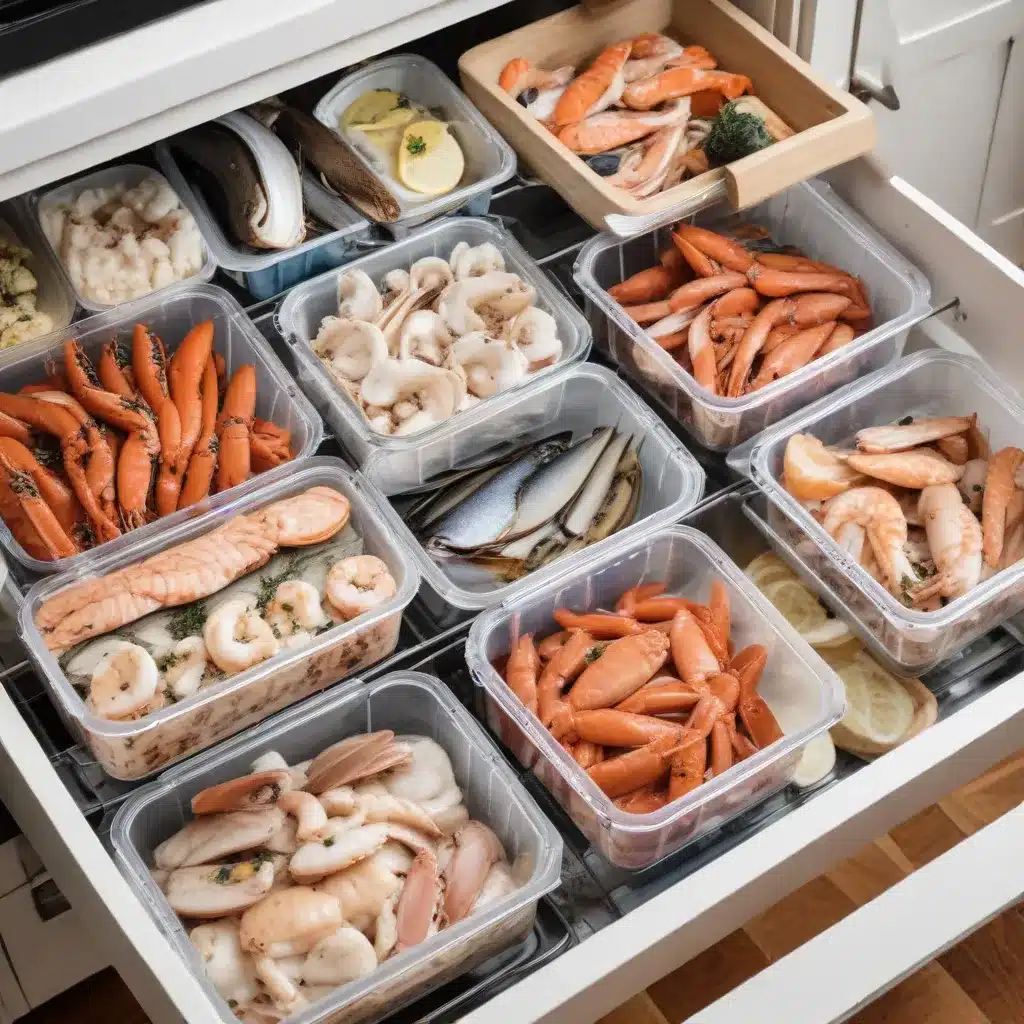
Conquer the Kitchen with Foolproof Seafood Storage Tips for Flawless Meal Preparation
Seafood Preservation Fundamentals
Properly storing seafood, whether fresh or frozen, is the foundation for culinary mastery. Optimal chilling and freezing techniques are critical to preserving the delicate flavors and textures that make seafood a treasured ingredient. To safeguard the integrity of your seafood, focus on two key areas: packaging and storage conditions.
Chilling and Freezing Techniques
The path to tender, juicy cod or luscious shellfish begins with careful handling and storage. For fresh seafood, chill it immediately in an ice-filled cooler, keeping it just above freezing. This rapid cooling helps lock in freshness. When freezing, use airtight, moisture-proof packaging to shield against freezer burn. Wrap fish fillets or steaks in plastic wrap, then place in a resealable freezer bag, squeezing out excess air. Shellfish like shrimp and scallops fare best when frozen in a single layer on a baking sheet, then transferred to bags. This prevents clumping for easy portioning.
Proper Packaging Methods
Proper packaging is a seafood storage superpower. Vacuum sealing is an excellent option, as it removes all air to prevent oxidation. Alternatively, double-bagging in freezer-safe plastic keeps air exposure minimal. Label packages with contents and freeze dates for at-a-glance inventory. When thawing, always place frozen seafood in the refrigerator—never at room temperature, which can breed dangerous bacteria.
Optimal Storage Conditions
Maintaining the right temperature is crucial. Refrigerate fresh seafood at 40°F or below, and freeze at 0°F or colder. Consistency is key; avoid repeatedly opening and closing the fridge or freezer, which allows cold air to escape. For best results, dedicate a section of your freezer exclusively to seafood, keeping it organized for easy access.
Navigating the Seafood Marketplace
Sourcing top-quality seafood is the first step toward mouthwatering dishes. Whether browsing the fish counter or scanning labels, there are a few key things to look for.
Selecting Top-Quality Ingredients
When choosing cod or other fish, look for bright, clear eyes, firm flesh, and a fresh, briny aroma. Avoid any seafood that appears discolored, slimy, or has a strong “fishy” odor. For shellfish, select ones that are free of cracks or chips and have a tight, intact shell. If buying live, ensure they’re actively moving.
Understanding Seafood Labels and Certifications
Seafood labels can be a treasure trove of information. Look for descriptors like “wild-caught,” “sustainably sourced,” or “eco-friendly” to ensure you’re making environmentally conscious choices. Third-party certifications like the Marine Stewardship Council (MSC) logo also indicate responsible harvesting practices.
Sustainable Sourcing Considerations
Sustainability is a growing concern for seafood lovers. When possible, seek out local fisheries and producers that prioritize ethical, eco-friendly methods. This not only supports your community but also reduces the carbon footprint of your ingredients. For global options, research fishing techniques and species conservation status to make informed decisions.
Prepping Seafood for Flawless Meals
Proper thawing and handling are crucial for preserving the quality of your seafood. Follow these guidelines to ensure your ingredients are ready for culinary magic.
Thawing and Handling Protocols
When defrosting frozen cod or other seafood, always use the refrigerator, not the countertop. Slow, gradual thawing preserves texture and freshness. Plan ahead, as this process can take up to 24 hours, depending on the size of your portions. Avoid rinsing seafood under running water, which can encourage bacterial growth. Instead, thaw in the package or in a covered bowl in the fridge.
Cleaning and Portioning Techniques
For the best results, clean and portion your seafood just before cooking. Carefully remove any bones, shells, or membranes, taking care to avoid cross-contamination. Portion fillets or steaks into evenly sized pieces to ensure uniform cooking. When it comes to shellfish, gently scrub the shells and discard any that won’t close properly.
Mastering Seafood Cooking Methods
With your seafood expertly stored and prepped, it’s time to unleash your culinary prowess. Explore a range of cooking techniques to make the most of your ingredients.
Dry-Heat Cooking Approaches
For a golden crust and tender interior, pan-sear or grill your cod fillets. These dry-heat methods caramelize the surface while keeping the center moist and flaky. When broiling, keep a close eye to prevent overcooking. For a unique twist, try en papillote (in parchment) cooking, which gently steams the fish in its own juices.
Moist-Heat Cooking Techniques
Gentle, moist-heat methods like poaching and steaming are excellent for delicate seafood. Poach cod or other white fish in a flavorful court-bouillon for a silky texture. Steaming shellfish like clams and mussels in white wine or broth allows their natural sweetness to shine. For heartier fare, braise fish or seafood in a savory liquid for fork-tender results.
Meal Preparation and Presentation
The final steps in seafood mastery involve thoughtful seasoning and plating techniques that elevate your dishes.
Flavor Pairing and Seasoning
Seafood’s delicate flavor profile pairs beautifully with a variety of seasonings. Enhance the natural taste of cod with fresh herbs like dill, parsley, or chives. Citrus notes from lemon or lime juice provide a refreshing contrast. For a gluten-free touch, experiment with rice vinegar, mirin, or coconut aminos in place of soy sauce.
Plating and Garnishing Tips
Presentation is key when serving seafood. Arrange your perfectly cooked protein with an eye-catching composition. Garnish with vibrant microgreens, thinly sliced citrus, or a drizzle of mignonette sauce for an impressive finish. Complementary sides like roasted vegetables or a crisp salad contribute both flavor and visual appeal.
With these foolproof seafood storage and preparation techniques, you’ll be well on your way to culinary mastery. Whether you’re whipping up a quick weeknight cod dish or an elaborate seafood feast, these strategies will ensure your ingredients shine. Conquer the kitchen, one delectable bite at a time.

